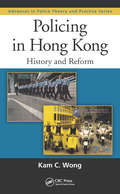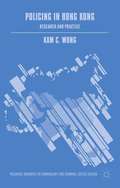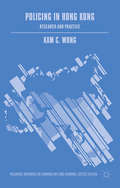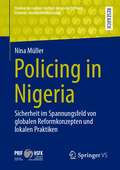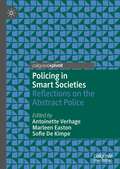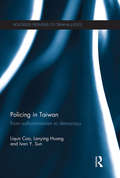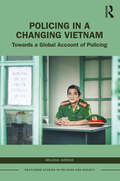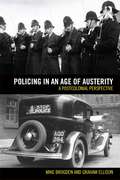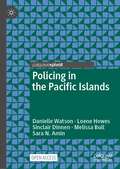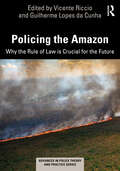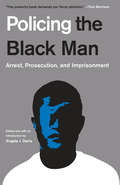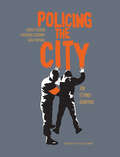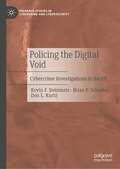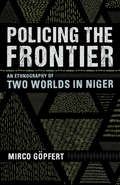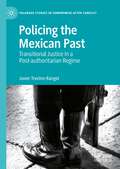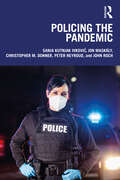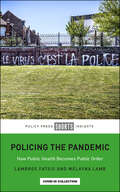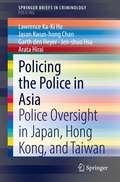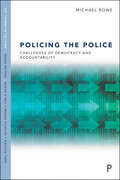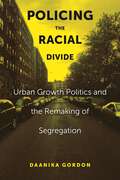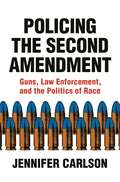- Table View
- List View
Policing in Hong Kong: History and Reform (Advances in Police Theory and Practice)
by Kam C. WongThe HKP (Hong Kong Police),Asia‘s Finest is a battle-tested professional organization with strong leadership, competent staff, and deep culture. It is also a continuously learning and reforming agency in pursuit of organisational excellence. Policing in Hong Kong: History and Reform is the first and only book on the development of the Hong Kong
Policing in Hong Kong: Research and Practice (Palgrave Advances in Criminology and Criminal Justice in Asia #23)
by Kam C. WongPolicing in Hong Kong.
Policing in Hong Kong: Research and Practice (Palgrave Advances in Criminology and Criminal Justice in Asia)
by Kam C. WongThis comprehensive book examines the state of research on policing in Hong Kong. It surveys the history and development of the field of police studies in Hong Kong, and examines the various methods, problems and prospects in the field.
Policing in Israel: Studying Crime Control, Community, and Counterterrorism (Advances in Police Theory and Practice)
by David Weisburd Tal Jonathan-Zamir Badi Hasisi"It is hoped that, through this series, it will be possible to accelerate the process of building knowledge about policing and help bridge the gap between the two worlds the world of police research and police practice. This is an invitation to police scholars and practitioners across the world to come and join in this venture." Dilip K. Das, PhD,
Policing in Nigeria: Sicherheit im Spannungsfeld von globalen Reformkonzepten und lokalen Praktiken (Studien des Leibniz-Instituts Hessische Stiftung Friedens- und Konfliktforschung)
by Nina MüllerDieses Buch beschäftigt sich mit der lokalen Wahrnehmung ausgewählter Maßnahmen innerhalb der Polizeireform in Nigeria. Die nigerianische Gesellschaft ist von tiefgreifenden Sicherheitsdefiziten geprägt, da u.a. das Misstrauen zwischen uniformierten Vertretern der Staatsmacht und der Bevölkerung groß ist. Das Erkenntnisinteresse der ethnografischen Arbeit ist es, zu erforschen, ob und wie sich die von internationalen und nationalen Akteuren betriebenen Reformbemühungen für eine verbesserte Sicherheitsarchitektur auf lokaler Ebene im Alltag manifestieren und welchen Aushandlungsprozessen sie dabei unterliegen.
Policing in Smart Societies: Reflections on the Abstract Police (Palgrave's Critical Policing Studies)
by Antoinette Verhage Marleen Easton Sofie De KimpeSmart societies pose new challenges for police organizations. Demands for more efficiency and effectiveness test police organizations which are often resistant to change. This book uses the concept of the abstract police to describe the way in which police organizations have tried to adapt to these new evolutions and the consequences. The chapters stem from a conference called “Street Policing in a Smart Society” which sought to frame and analyse these developments in policing. In this book, the concept of the abstract police is introduced, analysed and then challenged from different angles, looking at the evolutions related to technology, plural policing, police discretion and police decision making. As such, the book is a reflection of current debates on policing and police organization, aiming to give input to the debate by providing new insights on police and police work.
Policing in Taiwan: From authoritarianism to democracy (Routledge Frontiers of Criminal Justice)
by Ivan Y. Sun Liqun Cao Lanying HuangThe police in Taiwan played a critical role in the largely peaceful transition from an authoritarian regime to a democracy. While the temptation to intervene in domestic politics was great, the top-down pressure to maintain a neutral standing facilitated an orderly regime change. This is the first monograph to examine the role of the police as a linkage between the state and civil society during the democratic transition and the role of the police in contemporary Taiwan. Starting with a brief history of Taiwan, this book examines the development of policing in Taiwan from a comparative, environmental, historical, operational, philosophical and political perspective; considers the role of the police in the democratic transition; and draws comparisons between police cultures in the East and in the West – both now and in the past. Taiwan operates as a modern country within an East Asian culture and this book shows that Taiwan’s move towards democracy may have political ramifications for the rest of the nations in the area. Including references to literature on policing in China and the U.S, this book about Taiwan police may serve as a springboard for academics and students to learn about similar cultures in this important area of the world. Policing in Taiwan will be of interest to academics and students who are engaged in the study of criminology, criminal justice, policing studies and Asian studies, as well as the general reader.
Policing in a Changing Vietnam: Towards a Global Account of Policing (Routledge Studies in Policing and Society)
by Melissa JardineKnowledge about policing has been produced and disseminated unevenly so that our understanding comes from a skewed emphasis on the Anglo-American experience. Drawing on an original and comprehensive study of policing in Vietnam and engaging a Southern Criminological framework, this book explores police cultures and practices in a postcolonial, post-Confucian, transitioning economy. Identifying both similarities and differences in policing and police culture in Vietnam with those found in the dominant literature from the Global North, Policing in a Changing Vietnam challenges assumptions that police are (purportedly) apolitical, averse to tertiary education and defer to legalistic approaches to policing and law enforcement. It highlights that the variations identified in policing in Vietnam must be understood, not as deviations from Anglo-American normality, but as significant separate practices and traditions of policing from which the Global North may have something to learn. Contributing to ongoing debates on police culture and socialisation, this book explores the assumptions about relationships between the police, political systems, broad societal cultures, legal frameworks, organisations, communities and gender. An accessible and compelling read, this book will appeal to students and scholars of criminology, policing, gender studies, sociology, politics, law and all those who are interested in understanding the experiences and views of the Vietnamese police.
Policing in an Age of Austerity: A postcolonial perspective
by Graham Ellison Mike BrogdenPolicing in an Age of Austerity uniquely examines the effects on one key public service: the state police of England and Wales. Focusing on the major cut-backs in its resources, both in material and in labour, it details the extent and effects of that drastic reduction in provision together with related matters in Scotland and Northern Ireland. This book also investigates the knock-on effect on other public agencies of diminished police contribution to public well-being. The book argues that such a dramatic reduction in police services has occurred in an almost totally uncoordinated way, both between provincial police services, and also with regard to other public agencies. While there may have been marginal improvements in effectiveness in certain contexts, the British police have dramatically failed to seize the opportunity to modernize a police service that has never been reformed to suit modern exigencies since its date of origin in 1829. British policing remains a relic of the past despite the mythology by which it increasingly exports its practices and officers to (especially) transitional societies. Operating at both historical and contemporary levels, this book furnishes a mine of current information. Critically, it also emphasizes the extent to which British policing has traditionally concentrated on the lowest socio-economic stratum of society, to the neglect of the policing of the more powerful. Policing in an Age of Austerity will be of interest to academics and professionals working in the fields of criminal justice, development studies, and transitional and conflicted societies, as well as those with an interest in the social schisms caused by the current financial crisis.
Policing in an Age of Reform: An Agenda for Research and Practice (Palgrave's Critical Policing Studies)
by Timothy Parsons James J. Nolan Frank CrispinoThis book tackles the contentious issue of policing in an age of controversy and uncertainty. It is a timely book written by police scholars — predominantly former practitioners from Europe, Australia and North America — who draw from their own research and operational experiences to illuminate key issues relating to police reform in the present day. While acknowledging some relevance of usual proposed models, such as problem-solving, evidence-based policing and procedural justice, the contributors provide an insider look at a variety of perspectives and approaches to police reform which have emerged in recent decades. It invites university students, criminologists, social scientists, police managers, forensic scientists to question and adapt their perspectives on a broad range of topics such as community policing, hate crime, Islamic radicalisation, neighborhood dynamics, situational policing, antidiscrimination and civil society, police ethics, performance measures, and advances in forensic science, technology, intelligence and more in an accessible and comprehensive manner.
Policing in the Era of AI and Smart Societies (Advanced Sciences and Technologies for Security Applications)
by Babak Akhgar Hamid Jahankhani Mohammad Dastbaz Peter CochraneThis book presents a compilation of collaborations between researchers and practitioners in the fields of policing and cyber criminology, IT law and security, providing a comprehensive overview of current and emerging challenges in law enforcement, AI and Digital Society. The advent of Artificial Intelligence (AI), together with the spread of Internet of Things (IoT) devices, is creating smart societies that are increasingly interconnected. The scope of connectivity, massive rise in the volume of smart devices and growing interfaces between humans and technology, together with the expansion of Big Data and volumetric metadata generated and collated, are driving the cultural change toward Industry 4.0. Therefore, in light of do-it-yourself biohackers trying to become cyborgs, Augmented Humanity (fusion between humans and technology), governments’ utilization of the various technologies (example eHealth), holographic communications, smart cities / smart societies, cryptocurrencies etc., in the era of Industry 4.0 with AI at its core, enhancing their policing models has become a priority for governments. As the patterns of crime, policy and technology are changing in line with smart societies, law enforcement agencies around the world are called upon to formulate future-ready legislative frameworks, rethink crime prevention, investigatory decision making and predictive policing, prevent or mitigate potentially devastating cyber-attacks, and ensure the security of operational capabilities, namely: Command, Control, Communications and Intelligence (C3I).
Policing in the Pacific Islands (Palgrave's Critical Policing Studies)
by Danielle Watson Sara N. Amin Melissa Bull Loene Howes Sinclair DinnenThis open access book brings together insights into Pacific policing, conceptualising policing broadly as order maintenance involving the actions of multiple local, regional and international actors with sometimes competing and conflicting agendas. A complex and multifaceted endeavour, scholarship on this topic is relatively scarce and widely dispersed across diverse sources. It examines how Pacific policing is shaped by changing state-society relations in different national contexts and ongoing processes of globalisation. Particular attention is given to the plural character of Pacific policing, profound challenges of gender equity, changing dynamics of crime, and the prominence of transnational policing in resource and capacity constrained domestic environments. The authors draw on examples from across the Pacific islands to provide a nuanced and contextualised account of policing in this socially diverse and rapidly transforming region.
Policing the Amazon: Why the Rule of Law is Crucial for the Future (Advances in Police Theory and Practice)
by Vicente Riccio Guilherme Lopes da CunhaThis edited collection discusses the rule of law in the Amazon and the capabilities of the region’s sovereign states to police their territory considering security matters. Comprised of nine countries, including a European Union member, the Amazon region features states facing political instability, poverty, social inequalities, high levels of corruption, and lack of trust by their populations. This context is aggravated by the presence of criminal organizations operating there and shaping transnational bonds. Notably, the world’s foremost cocaine-producing countries—Colombia, Peru, and Bolivia—are located in the region, presenting related turmoil and instability. Moreover, as home to the largest rainforest on Earth and the widest biodiversity, the region is an object of concern due to environmental reasons. The protection of these natural resources as well as the traditional peoples living there is intertwined with issues of development, security, and policing.The book delves into questions on the international agenda, such as: how is it possible to sustain the rule of law in the Amazon? What are the states’ capabilities for controlling the territory and enforcing the law? How do these states deal with the growing urban violence in the region? What are the capabilities of public authorities for proposing laws and policies, and judicial systems to process, prevent, and suppress different crimes such as drug dealing, smuggling, human trafficking, terrorism, and environmental crimes?The book fills a gap in English-language scholarship exploring the context of the rule of law in the Amazon and the impact on policing activities. It is ideal for a wide range of audiences, including policing scholars, law enforcement and community leaders, and students focusing on criminal justice and the Amazon.
Policing the Black Man: Arrest, Prosecution, and Imprisonment
by Edited and with an introduction by Angela J. DavisA comprehensive, readable analysis of the key issues of the Black Lives Matter movement, this thought-provoking and compelling anthology features essays by some of the nation&’s most influential and respected criminal justice experts and legal scholars.&“Somewhere among the anger, mourning and malice that Policing the Black Man documents lies the pursuit of justice. This powerful book demands our fierce attention.&” —Toni MorrisonPolicing the Black Man explores and critiques the many ways the criminal justice system impacts the lives of African American boys and men at every stage of the criminal process, from arrest through sentencing. Essays range from an explication of the historical roots of racism in the criminal justice system to an examination of modern-day police killings of unarmed black men. The contributors discuss and explain racial profiling, the power and discretion of police and prosecutors, the role of implicit bias, the racial impact of police and prosecutorial decisions, the disproportionate imprisonment of black men, the collateral consequences of mass incarceration, and the Supreme Court&’s failure to provide meaningful remedies for the injustices in the criminal justice system. Policing the Black Man is an enlightening must-read for anyone interested in the critical issues of race and justice in America.
Policing the City: An Ethno-graphic
by Didier Fassin Frédéric DebomyAdapted from the landmark essay Enforcing Order, this striking graphic novel offers an accessible inside look at policing and how it leads to discrimination and violence.What we know about the forces of law and order often comes from tragic episodes that make the headlines, or from sensationalized versions for film and television. These gripping accounts obscure two crucial aspects of police work: the tedium of everyday patrols under constant pressure to meet quotas, and the banality of racial discrimination and ordinary violence. Around the time of the 2005 French riots, anthropologist and sociologist Didier Fassin spent fifteen months observing up close the daily life of an anticrime squad in one of the largest precincts in the Paris region. His unprecedented study, which sparked intense discussion about policing in the largely working-class, immigrant suburbs, remains acutely relevant in light of all-too-common incidents of police brutality against minorities. This new, powerfully illustrated adaptation clearly presents the insights of Fassin&’s investigation, and draws connections to the challenges we face today in the United States as in France.
Policing the Digital Void: Cybercrime Investigations in the US (Palgrave Studies in Cybercrime and Cybersecurity)
by Kevin F. Steinmetz Brian P. Schaefer Don L. KurtzThis accessible book examines American law enforcement cybercrime investigations. Through semi-structured interviews with forty-seven cybercrime law enforcement investigators, it explores the characteristics of investigators, the development of cybercrime units and task force programs in the US, the processes involved in these investigations, and the culture of American cybercrime investigations. This includes how cybercrime investigators relate to police occupational culture, their perceptions of offenders and victims, and use of humor. It also considers the technological, economic, political, and cultural contexts that shape and structure cybercrime investigations, units, and task forces. It adopts a sociological approach to the study of cybercrime policing by tracing connections between the individual and organizational levels of analysis to the macro-structural. In other words, it situates cybercrime policing in the “big picture” of technological change, the political economic of internet platforms, the transformation of “force” in the internet age, and related matters. Finally, this book builds from this comprehensive analysis of American policing to discuss pathways forward by curating institutional and organizational policy suggestions to promote both effective and just cybercrime policing.
Policing the Favelas of Rio de Janeiro: Cosmologies of War and The Far-Right (Palgrave's Critical Policing Studies)
by Tomas SalemThis book offers a unique look into the world of policing and the frontline of Brazil’s war on drugs. It analyzes the tensions produced by attempts to modernize Rio de Janeiro’s public security policies. Since the return of democracy in 1985, Rio's police forces have waged war against armed drug gangs based in the city’s favelas, casting the people who live in these communities as internal enemies. In preparation for the Olympics in 2016, the police sought to ‘pacify’ the favelas and their populations through the establishment of Pacifying Police Units (UPPs) in many of the city’s favela communities. Drawing on eight months of ethnographic fieldwork with the police, this book follows officers across the institutional hierarchy in their daily activities, on patrol, and during training. Tracing the genealogies of contemporary forms of policing-as-warfare through the notion of ‘colonial war’ and ‘cultural war’, it highlights the material and ideational dimensions of war as a cosmological force that shapes Brazilian social relations, subjectivities, landscapes, economies, and politics. It draws on the Deleuzian notion of ‘war machine and state dynamics’ to show how practices of elimination co-exist with attempts to transform favela territories and their people and analyzes the link between the moral universe of policing and right-wing populism in Brazil. Through rich and nuanced ethnography, it offers a critical perspective on militarized policing and 21st century forms of authoritarianism.
Policing the Frontier: An Ethnography of Two Worlds in Niger (Police/Worlds: Studies in Security, Crime, and Governance)
by Mirco GöpfertIn Policing the Frontier, the second book in the Police/Worlds series Mirco Göpfert explores what it means to be a gendarme investigating cases, writing reports, and settling disputes in rural Niger. At the same time, he looks at the larger bureaucracy and the irresolvable tension between bureaucratic structures and procedures and peoples' lives. The world of facts and files exists on one side, and the chaotic and messy human world exists on the other.Throughout Policing the Frontier, Göpfert contends that bureaucracy and police work emerge in a sphere of constant and ambivalent connection and separation. Göpfert's frontier in Niger (and beyond) is seen through ideas of space, condition, and project, packed with constraints and possibilities, riddled with ambiguities, and brutally destructive yet profoundly empowering. As he demonstrates, the tragedy of the frontier becomes as palpable as the true impossibility of police work and bureaucracy.
Policing the Mexican Past: Transitional Justice in a Post-authoritarian Regime (Palgrave Studies in Compromise after Conflict)
by Javier Trevino-RangelThis book critically examines transitional justice in Mexico. It explores how the Mexican democratic regime dealt with the grave human rights violations perpetrated by security forces during the authoritarian era (1929-2000) through a Special Prosecutor’s Office. It offers a complete account of the diverse factors that facilitated the emergence (and policing) of Mexico's transitional justice process. Whilst transitional justice should contribute to the advancement of liberal democracy and, consequently, generate the following benefits: truth, justice, political reconciliation, peace, this book argues that Mexico is a case of transitional injustice. It is an example of how in some societies transitional justice mechanisms are intentionally implemented in ways that, instead of generating justice, produce impunity. It makes important contributions to some of the broader debates addressed by scholars on transitional justice and gives them reason to re-examine transitional justice processes in other countries in a new light.
Policing the Pandemic
by Peter Neyroud Sanja Kutnjak Ivković Jon Maskály Christopher M. Donner John RochPolicing the Pandemic explores how police agencies in United Kingdom and the United States have adjusted to their changing environments, both during the peak of the COVID-19 pandemic and later, when the restrictions have been relaxed and the societies have begun to develop their new normal.Combining interviews and surveys of police officers and police administrators from the United Kingdom and the United States, this book provides a systematic and empirically based account of these changes and elaborates on the lessons for the future. The book offers insight into organizational and operational changes brought on by the pandemic, including the changes in their workload, enforcement activities, and administrative changes. It examines police perceptions of, and compliance with, pandemic-related changes, any potential COVID-19-related training, and the frequency with which they used various responses when observing violations of COVID-19 regulations and laws. It also focuses on police officers’ own fear of contracting COVID-19, whether they had been diagnosed with COVID-19, and how the pandemic affected their own health, stress, and general well-being.This book is an essential reading for scholars, policymakers, and police administrators tackling issues such as procedural justice, organizational change, and police officer well-being, as well as those more widely engaged with societal and legal consequences of the pandemic, be it the COVID-19 pandemic or any future pandemics.
Policing the Pandemic: How Public Health Becomes Public Order
by Lambros Fatsis Melayna LambThe COVID-19 pandemic has highlighted the inadequacies of the state’s response to public health and public order issues through deeply flawed legislation. Written in the context of the #BlackLivesMatter protests, this book explores why law enforcement responses to a public health emergency are prioritised over welfare provision and what this tells us about the state’s criminal justice institutions. Informing scholarly, civic and activist thinking on the political nature of policing, it reveals how increasing police powers disproportionately affects Black people and suggests alternative ways of designing public safety beyond a law enforcement context.
Policing the Police in Asia: Police Oversight in Japan, Hong Kong, and Taiwan (SpringerBriefs in Criminology)
by Garth den Heyer Lawrence Ka-Ki Ho Jason Kwun-hong Chan Jen-shuo Hsu Arata HiraiThis brief offers an overview of the prevailing debates in police oversight and accountability through an analysis of policing in Hong Kong, Japan, and Taiwan. It places emphasis on three major controversies of oversight: professionalism, representation, and empowerment. Arguing that traditional models do not accurately depict variations in police systems in Asia, the volume aims to bring attention to the implementation of these three concepts and clearly articulate the power relationship within these Asian police oversight mechanisms. This brief will be a useful resource for researchers in policing as well as criminologists, political scientists, and sociologists, particularly those specializing in East Asia.
Policing the Police: Challenges of Democracy and Accountability (Key Themes in Policing)
by Michael RoweHow does society hold its police to account? It’s a vital part of upholding law and liberty but changing modes of policing delivery and new technologies call for fresh thinking about the way we guard our guards. This much-needed new book from leading criminology professor Michael Rowe, part of the ‘Key Themes in Policing’ series, explores issues of governance, discipline and transparency, ranging across subjects including ethics, governance, discipline and transparency. The landmark new study: • Showcases how social change and rising inequalities make it more difficult to ensure meaningful accountability; • Addresses the impact of Evidence-Based Policing strategies on the direction and control of officers; • Sets out a game-changing agenda for ensuring democratic and answerable policing. For policing students and practitioners, it’s an essential guide to modern-day accountability.
Policing the Racial Divide: Urban Growth Politics and the Remaking of Segregation
by Daanika Gordon2023 Edwin H. Sutherland Book Award WinnerA behind-the-scenes account of the harsh realities of policing in a segregated city For thirteen months, Daanika Gordon shadowed police officers in two districts in “River City,” a profoundly segregated rust belt metropolis. She found that officers in predominantly whiteneighborhoods provided responsive service and engaged in community problem-solving, while officers in predominantly Black communities reproduced long-standing patterns of over-policing and under-protection. Such differences have marked US policing throughout its history, but policies that were supposed to alleviate racial tensions in River City actually widened the racial divides. Policing the Racial Divide tells story of how race, despite the best intentions, often dominates the way policing unfolds in cities across America.Drawing on in-depth interviews and hundreds of hours of ethnographic observation, Gordon offers a behind-the-scenes account of how the police are reconfiguring segregated landscapes. She illuminates an underexplored source of racially disparate policing: the role of law enforcement in urban growth politics. Many postindustrial cities are increasing the divisions of segregation, Gordon argues, by investing in downtowns, gentrified neighborhoods, and entertainment corridors, while framing marginalized central city neighborhoods as sources of criminal and civic threat that must be contained and controlled. Gordon paints a sobering picture of modern-day segregation, and how the police enforce its racial borders, showing us two separate, unequal sides of the same city: one where rich, white neighborhoods are protected, and another where poor, Black neighborhoods are punished.
Policing the Second Amendment: Guns, Law Enforcement, and the Politics of Race
by Jennifer CarlsonAn urgent look at the relationship between guns, the police, and raceThe United States is steeped in guns, gun violence—and gun debates. As arguments rage on, one issue has largely been overlooked—Americans who support gun control turn to the police as enforcers of their preferred policies, but the police themselves disproportionately support gun rights over gun control. Yet who do the police believe should get gun access? When do they pursue aggressive enforcement of gun laws? And what part does race play in all of this? Policing the Second Amendment unravels the complex relationship between the police, gun violence, and race. Rethinking the terms of the gun debate, Jennifer Carlson shows how the politics of guns cannot be understood—or changed—without considering how the racial politics of crime affect police attitudes about guns.Drawing on local and national newspapers, interviews with close to eighty police chiefs, and a rare look at gun licensing processes, Carlson explores the ways police talk about guns, and how firearms are regulated in different parts of the country. Examining how organizations such as the National Rifle Association have influenced police perspectives, she describes a troubling paradox of guns today—while color-blind laws grant civilians unprecedented rights to own, carry, and use guns, people of color face an all-too-visible system of gun criminalization. This racialized framework—undergirding who is “a good guy with a gun” versus “a bad guy with a gun”—informs and justifies how police understand and pursue public safety.Policing the Second Amendment demonstrates that the terrain of gun politics must be reevaluated if there is to be any hope of mitigating further tragedies.
